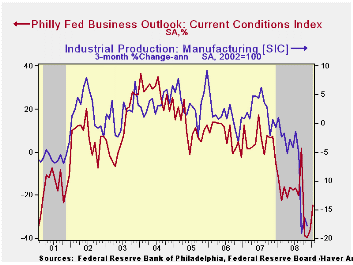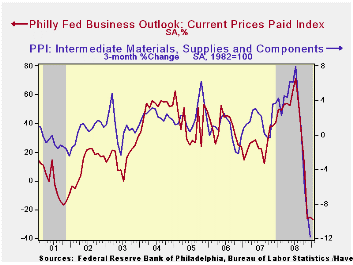 Global| Jan 15 2009
Global| Jan 15 2009Philadelphia Fed Index Improved Slightly But Still Low
by:Tom Moeller
|in:Economy in Brief
Summary
The Philadelphia Federal Reserve Bank indicated that its January Index of General Business conditions in the manufacturing sector rose slightly from the recent monthly lows. However, the index at -24.3 this month was still only [...]

The Philadelphia Federal Reserve Bank indicated that its
January Index of General Business conditions in the manufacturing
sector rose slightly from the recent monthly lows. However, the index
at -24.3 this month was still only slightly better than the lows of the
prior two recessions. A weaker reading of -35 had been expected for
this month.
During the last ten years there has been a 71% correlation between the level of the Philadelphia Fed Business Conditions Index and the three-month growth in factory sector industrial production. There has been a 54% correlation with q/q growth in real GDP.
The Philadelphia Fed constructs a diffusion index for total business activity and each of the sub-indexes. The business conditions index reflects a separate survey question.
The employment index weakened sharply to the lowest level since the recession of 1975. A record forty eight percent of respondents expected to reduce employment levels while only nine percent expected to raise them. During the last ten years there has been a 79% correlation between the index level and the m/m change in manufacturing sector payrolls.
The new orders index ticked up slightly to a reading of -22.3 and the shipments index also recovered all of its sharp December decline.
The prices paid index fell, for the third month, to a record low. During the last ten years there has been a 69% correlation between the prices paid index and the three-month growth in the intermediate goods PPI. There has been an 82% correlation with the change in core intermediate goods prices. Just eleven percent of respondents increased prices this month versus thirty eight percent that lowered them.
The separate index of expected business conditions in six months rose slightly to its highest level since September. The expectations index for new orders led the improvement but the expectations index for employment fell to a record low.
The Philadelphia Fed figures can be found in Haver's SURVEYS database.
The latest Business Outlook Survey from the Federal Reserve Bank of Philadelphia can be found here.
The Fed, Liquidity, and Credit Allocation from the Federal Reserve Bank of St. Louis can be found here.
| Philadelphia Fed (%) | January | December | January '08 | 2008 | 2007 | 2006 |
|---|---|---|---|---|---|---|
| General Activity Index | -24.3 | -36.1 | -12.0 | -21.3 | 5.0 | 8.0 |
| Prices Paid Index | -27.0 | -25.5 | 49.8 | 36.4 | 26.3 | 36.7 |
Tom Moeller
AuthorMore in Author Profile »Prior to joining Haver Analytics in 2000, Mr. Moeller worked as the Economist at Chancellor Capital Management from 1985 to 1999. There, he developed comprehensive economic forecasts and interpreted economic data for equity and fixed income portfolio managers. Also at Chancellor, Mr. Moeller worked as an equity analyst and was responsible for researching and rating companies in the economically sensitive automobile and housing industries for investment in Chancellor’s equity portfolio. Prior to joining Chancellor, Mr. Moeller was an Economist at Citibank from 1979 to 1984. He also analyzed pricing behavior in the metals industry for the Council on Wage and Price Stability in Washington, D.C. In 1999, Mr. Moeller received the award for most accurate forecast from the Forecasters' Club of New York. From 1990 to 1992 he was President of the New York Association for Business Economists. Mr. Moeller earned an M.B.A. in Finance from Fordham University, where he graduated in 1987. He holds a Bachelor of Arts in Economics from George Washington University.






